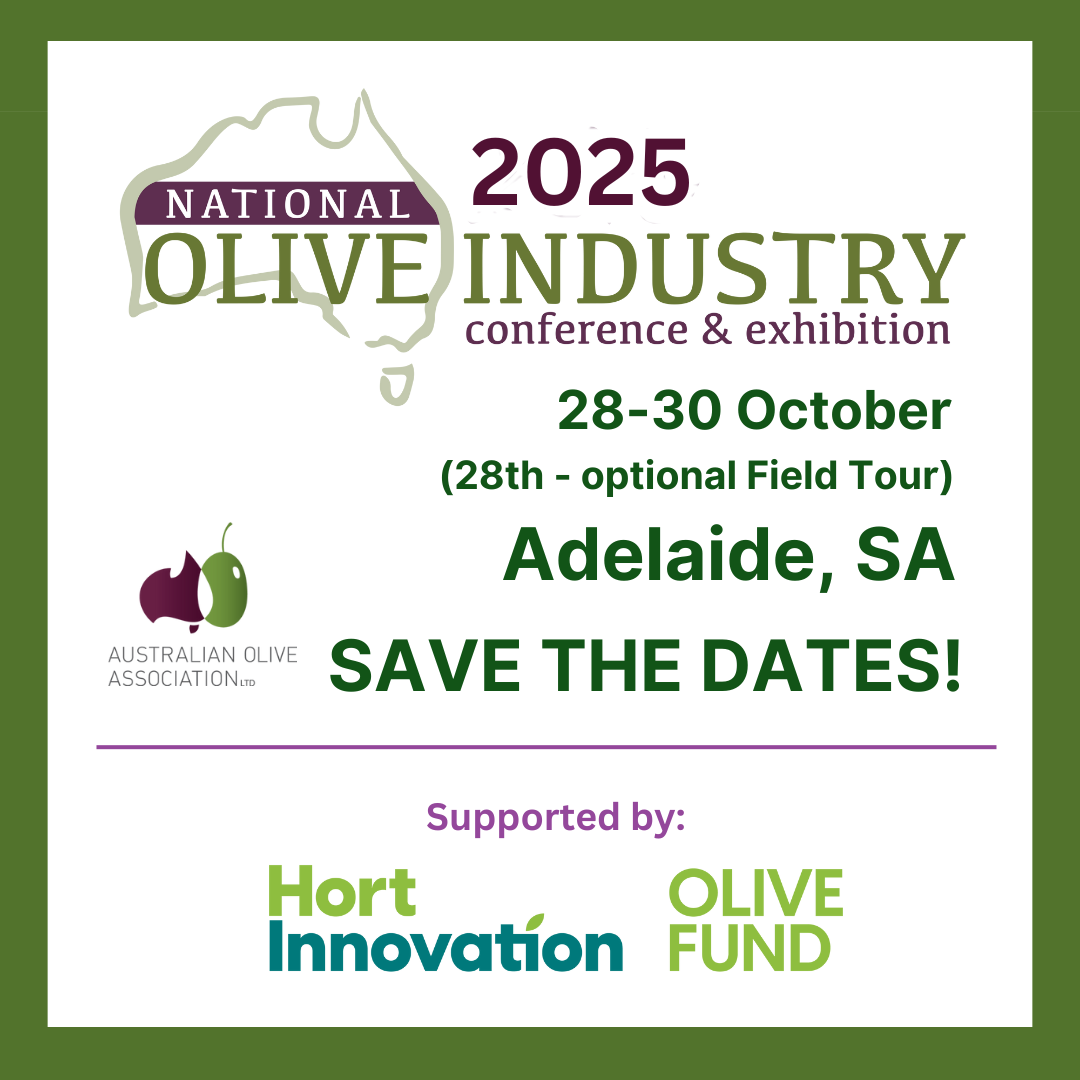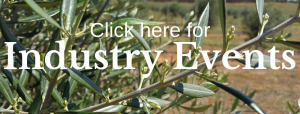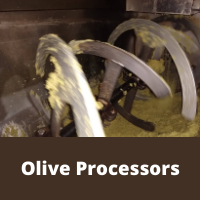Paul Miller,
President Australian Olive Association,
28 September 2001 to 23 November 2015
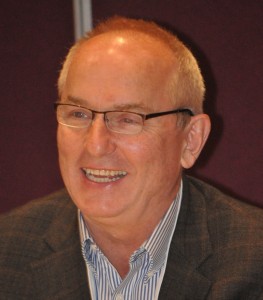
Paul Miller, 2015
1. Brief Biography
I was born in Yea, Victoria in 1956. I grew up on a small sheep and cattle farm in Glenburn, near Yea. My parents were small farmers and they were fine people. My dad was a gentle, generous, hard-working man and my mum was smart, strict and big on education. I have two sisters and one brother, all older than me. On the farm the work came first – working sheep, carting hay, cutting wood, all good things for a growing boy. Early fun was fishing, walking and decimating the rabbit population.
I went to school first at Glenburn Primary with a total of about 16 children in the whole school. I was the only one in my grade in some years and I did grades 3 and 4 in one year. I got a shock when I went to Yea High School with 180 other students, and a real shock when I went to Trinity Grammar School in Melbourne for years 11 and 12 as a boarder with about 1000 students in the school!
Thanks to my mother I was academically capable and was able go to Trinity on a scholarship. In year 12 I had scores to enter almost any university course but chose Agriculture because I was awarded a Cadetship with the Victorian Department of Agriculture to do Ag Science at La Trobe University. I graduated in 1977 and I was the last Cadet under that program.
During my university course I worked for the Shell Chemicals Agrochemical research unit over the holidays. I was lucky to get that job; the researchers were some of the best scientists and people that I have ever worked with.
From 1977 to 1986 I worked at the Horticultural Research Institute at Knoxfield, a suburb of Melbourne. I did research on fruit trees, in particular apples and cherries to do with crop regulation, how trees grew in Australia compared with other climates and the use of plant growth regulators to modify tree growth. Once again I was lucky to work with some excellent people.
In 1986 I started my private consulting and research company Pomology Pty Ltd, that is still going today. Since then I have done contract research, grown apples with my brother at Harcourt in Victoria, had management roles in farming companies growing temperate and tropical fruits and flowers, done studies for government and private companies, worked in insolvency cases for banks, done expert witness work, planted a 172 ha vineyard with some partners at Lake Marmal Victoria in 1998, researched frying oil technology, worked as a director of several companies in the wine and olive industries in Victoria, South Australia and WA, done technical work in both industries, helped to found New Rural Industries Australia with RIRDC, set up EVA in California with Alexandra Kicenik Devarenne, and of course I have been President of the AOA since 2001.
2. Family and Children
In 1991 I married Kate Metcalf, a lawyer and archaeologist, and we lived in Melbourne until the marriage ended in 2012. We had our son Patrick in 1992 and Kate’s son from a previous marriage James who is 8 years older than Patrick. Those boys grew up to be sensational young men today. Nothing has been more amazing in my life than the birth of Patrick or more pleasurable to watch than the boys growing up.
My family had to put up with my olive oil obsession, which often took me away from them both physically and mentally. For that I sincerely apologize and I thank them for their support.
3. My Professional Time in Olive Oil – 1995 to Now
My professional interest in olive oil began in 1995 when I started doing consulting work on olive farming with local government in northern Victoria. I completed a major study for the Victorian Government and the Bendigo, Loddon and Gannawarra Shires in 1997 – Olives an Opportunity Study. This 300 page report still makes interesting reading today.
In 1999 I was approached by Deloitte regarding a project in South Australia and I ended up being the managing director of Coonalpyn Olives, a 214 ha olive farm, from 2000 to 2007, when it was bought out by one of the investors. This project employed Jim and Lisa Rowntree, who have become two of my best colleagues and friends.
I also worked as a director of Red Island Limited, located first in WA then Melbourne, and Tatiara Olive Processing at Keith in South Australia.
I have done many and various consulting jobs involving olive oil in Australia and elsewhere, including in Georgia and California in the USA, and in Japan. I have found this work particularly interesting.
Since 2012 I have been establishing the Extra Virgin Alliance with Alexandra Kicenik Devarenne. This work with Alexandra has given me an amazing expanded international network of producers and experts in 13 countries. In my opinion EVA is doing the best educational work to date on olive oil. This is focused on the supply chain and consumers in the USA but also looking at Japan and other markets. EVA is of course another not-for-profit organization: one day I will learn!
Early this year I took on the project OL14003 for HIA, which will finish in mid-2016. This is my first paid involvement in such a project. The project is called “Essential Work to Facilitate Increased Exports to China, Removing Roadblocks and Enhancing Competitive Advantage”; a ridiculously long name. Originally this was to be overseen by the AOA but at the time it was approved by HAL the political environment was so difficult towards industry peak bodies that HAL felt it was safer to find a private entity to manage it. After searching various alternatives I volunteered my company, and HAL and the AOA agreed. Because I don’t have any involvement with a brand but have the research and industry experience it seemed to work procedurally and politically. There has been some questioning about me as President (a voluntary position) taking on private work paid for by the levy. I think I am well qualified to oversee the work and lead the project; I will be remunerated a minor proportion of the project funding for co-ordination and oversight, with the bulk of the funds being used for third party market research, training development and laboratory work. Updates are being provided to producers who came to the Olive Route seminars, in each quarterly edition of Olivegrower & Processor, and HIA will have the milestone reports available on their website soon.
I hope that OL14003 signals a shift in how the industry approaches research. This is a broad integrated project aimed squarely at facilitating the market for high quality olive oil in China. It tackles hurdles like the Chinese regulations for contaminants, it seeks technology to protect our olive oil in transit, it seeks technology to prevent fraudulent re-filling, it seeks to find technical partners in China to validate our quality claims “off-the-shelf” in China, it does crucial market research, it develops training and certification for exporters, and most importantly it opens our eyes to new possibilities. I am thrilled to be part of this, working alongside Chris Mercer who fortunately for us decided to grow olives at Dongara, WA.
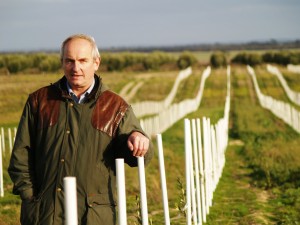
4. My Time With The AOA
I became a director of the AOA in 2000 and organized and ran the 2000 Conference in Bendigo. Then I became President of the AOA in 2001 at the Hunter conference. (I recall Professor Antonio Cimato outlining the problems with olive oil authenticity at that Conference. How right he was!)
I want to acknowledge Chuck L’Heureux, who worked as the AOA Secretariat with me for nearly10 years until July 2010. Chuck was great to work with, highly principled, so loyal and did a mighty job for the AOA.
Early on in my role as President I tried to get out amongst the members as much as I could. I have really enjoyed my times at the many, many regional and state meetings over the years. I have missed this interaction with local producers as my voluntary time has been taken up more and more on government and international quality matters.
I started to connect with government in Australia as soon as I could from 2001. I think that the AOA’s relationship with the Australian government through DAFF and RIRDC has been one of my achievements. Many AOA members have helped this work along the way but I think it has also been useful to have a leading well-known face of the organization nationally and internationally, especially in the work on standards and on the efforts to combat the unfair competition from mis-labelled products that unfortunately still occurs today.
The people I have worked with at DAFF have been great, very professional and have gone out of their way to help our initially fledgling industry. DAFF advised me on our quality strategy for olive oil and supported it with funding and attendance at many meetings, including seven Codex Alimentarius meetings. DAFF also facilitated meetings that I attended in Brussels and Madrid, as well as contact with other Departments such as DFAT, Customs and bodies like the ACCC and FSANZ.
Federal Ministers for Agriculture that I dealt with in particular were Peter McGauran and Tony Burke. Peter McGauran supported the Certified Australian Extra Virgin work with significant grant funding that I obtained, underpinning the Fresher is Better campaign alongside the development of the olive industry Code of Practice that I am particularly proud of. Many people worked on this and the best thing is that it is still going after six years and has expanded to cover table olives. Unlike most other such programs in the olive world, ours checks quality off the retail shelves. In other words, we check our oils where consumers buy them.
The program of promoting Fresher is Better at shows around Australia was very well supported by AOA members and we should always recall that as something very good that we did. Its lessons should not be forgotten as the AOA plans new consumer education work.
Tony Burke took these initiatives further and, through work I did with DAFF, he allowed DAFF to co-fund the work by Standards Australia to develop the Australian Standard for Olive Oils and Olive Pomace Oils, AS 5264-2011. This is something else that I am particularly proud of and I cannot mention it without acknowledging the superb work by Leandro Ravetti. I chaired and steered Committee FT-034 that oversaw the development of the Standard and alongside me Leandro simply made a lot of the really good work happen. He was awarded by Standards Australia for this work and the AOA gave him an award for this and all his many other truly remarkable contributions to the Australian industry. I clearly remember high fives with Leandro after we got a particularly contentious piece of the Standard over the line. I also remember Rob Solomon of DAFF holding the line in favor of good science when it really counted. It was good day in July 2011 when AS 5264-2011 was published after many years of work.
This brings me to a long association with RIRDC. I chaired the Olive Industry R&D Committee for RIRDC from 2004 to 2013. Initially the AOA worked with Max Burke, then Roslyn Prinsley and Alison Saunders. I worked closely with Roslyn and Alison, who were important people to the AOA as we took on the research that gave us the knowledge we now utilize (and should utilize more).
Roslyn initiated the brilliant and sadly short-lived New Rural Industries Australia. I chaired this unique body from 2009 to 2012 when, due mainly to changes in direction within RIRDC, it ceased to exist. It was educational, representing olives and working as an advocate and leader with 30 or so other new industries. It is a shame that Roslyn’s unique vision could not be taken further.
RIRDC and DAFF initiated two reviews of the olive industry representative structure that linked to the work on the Code of Practice. I recall being approached with offers of funding for this work because the industry was doing such a good job of pursuing product quality and promoting itself in Canberra. I take credit for some of this, alongside other AOA members who worked long and hard in the mid to late 2000s to create the industry representative structure that we now enjoy. The major work involved Courage Partners consultants in Canberra, in particular principal Noel Sutton who became a colleague and advocate for a time.
Since 2013 we have been with HAL, now HIA, for R&D and this was at the insistence of Minister Joe Ludwig. Although we had done occasional projects with HAL previously, we had wanted to stay with RIRDC as our R&D partner as we had a strong longstanding relationship. Coming into HAL just as it then had to transition to HIA has not been easy. Lisa Rowntree has been at the front line of this work and has done an excellent job.
In my opinion HIA has done a good job of getting to where it is now, given the incredibly difficult politically charged brief that it was given. I have been happy to work with its people since we first joined in 2013 and I hope that the relationship only gets stronger and better into the future.
Along the way we also formed and then disbanded the partnership companies Australian Olive Expo and The Olive Press, which had their pluses and minuses. I was a Director of both of these companies for the AOA. No doubt having the annual Conference and Expo in Canberra for five years to 2009 was of value, as we worked closely with the Federal Government during that period.
Having said that, of the 15 AOA annual Conferences that I have presided over two are standouts to me.
The first was in 2002 in Adelaide when Lisa Rowntree and her Olives SA team put on a superb upbeat event. The dinner in the Adelaide Town Hall was the best we have ever had. There was lots of optimism at that time and we had Fausto Luchetti, then Executive Director of the IOC, and the President of Olives NZ in attendance. I became friendly with Fausto after meeting him in 2001 and attending several IOC meetings that he was in charge of. Fausto was as good as it gets with regard to his diplomatic and people skills and he has always been an unwavering advocate of food quality. I travelled parts of Italy with him in 2004 and we still occasionally keep in touch. The IOC went downhill fast when Fausto left in 2003.
I met Flavio Zaramella, a friend of Luchetti’s, in the early 2000s. An expert on high quality food and wonderful company, Flavio also showed me around parts of Italy and gave me remarkable insights into the reality of the olive oil production and trade in that country. Brave man, Flavio.
The second standout conference was in Wangaratta in 2011 done in partnership with OPNEV. This was just after the Australian Standard AS 5264-2011 was published and also just after Tom Mueller’s book was released. I had met, been interviewed by and stayed with Tom during his work on his book Extra Virginity: The Sublime and Scandalous World of Olive Oil. Tom came to our meeting and gave an amazing talk.
So did Manuel Paras Rosa, Dean of the University of Jaen and invited by Leandro Ravetti. His work on olive oil labelling was the basis of the labelling in the Australian standard and there is much, much more that he has done over many years for the benefit of consumers and genuine producers. He is one of the good guys. Andries Rabie, my counterpart in South Africa, came too. Another one of the good guys, he and I still work together and I value his friendship and support.
Leandro, who helped put the program for the 2011 conference together, insisted that Alexandra Kicenik Devarenne attend. Alexandra had been working with Three E, a group of good producers and experts from Europe and elsewhere, and I had been to and spoken at one of their “Beyond Extra Virgin” meetings in 2009 in California. I was initially sceptical but as I got to know Alexandra in 2011 it became apparent that her dedication to the cause for quality producers was second to none, that she was immensely capable and that she was pointing out many things that we had missed.
Rod Mailer, a longstanding expert for Australian olive industry, expanded my horizons early in the 2000s by suggesting I attend meetings of the American Oil Chemists Society (AOCS) and the Euro Fed Lipid society (EFL), two important bodies for fats and oils technology. There is an after dinner story or two about our escapades at these meetings but Rod was right and these are important connections that I cultivated. I am proud to be a founding member of both the AOCS Expert Olive Oil Committee since 2009 and of the EFL Division of Olive Oil since 2007. I helped form both of these useful committees as well as to offer proficiency accreditation in both sensory analysis and the important methods put into our Standard. Richard Cantrill, the chief chemist at AOCS, has become a close colleague. I hope that Rod is happy with how I took on the opportunities.
These networks have helped me to do more and more international work for the AOA and I am now a member of the Olive Oil Commission of California Research Committee and the United States Pharmacopeia Olive Oil Authenticity Expert Panel – a diverse international group based in Maryland with Richard Cantrill as the Chair. I proudly represented AOCS at the pivotal EC meeting on the Authenticity of Olive Oil in 2013 in Madrid.
It had become apparent early in the 2000s that the issue of quality, fraud and mis-labelling of olive oil is a global problem. Experienced skilled food policy people at DAFF advised me how to tackle this complex problem – the problem that has ripped billions of dollars out of the olive oil market to the detriment of good producers everywhere, and has denied consumers real choice and therefore limited the market. These people advised me to attack the problem from every angle I could think of and to take new opportunities as they came along. So that is what I did and that is what I am still doing.
There is a misconception amongst new olive producing countries that somehow this is a uniquely ‘them and us’ problem (EU/Mediterranean versus new producers), or at least that the solution lies with new producers lining up against the EU and IOC. This simplistic view may feel good but it is wrong. Over the years I have made valuable connections within the EU and amongst the major producer and consumer countries in that region. No doubt the EU has been asleep at the whee,l especially during the 2000s, and that this has allowed this problem to grow. However, the many active producers, scientists and consumer advocates from where it all began and where about 60 % of the world’s olive oil is consumed have not been idle.
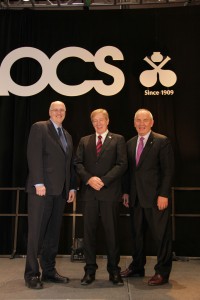
Photo: AOCS. Miller on stage at the 2014 American Oil Chemists’ Society meeting in Texas, with AOCS technical director Richard Cantrill and fellow Australian Rod Mailer.
I am hopeful that recent EU activities are a sign that the EU is now taking this problem more and more seriously and that Brussels is taking action; bureaucratic and careful action but action nonetheless. It is a big task; the large industrial packers of olive oil have become vested in a flawed and dishonest trade in olive oil and they lobby and work to protect the status quo or worse. On the other hand, the EU has immense power and recent action in Italy, work out of Brussels and the emerging dialogue and work in many other parts of Europe are encouraging.
In recent years I have come to know and respect Jean-Louis Barjol, the current Executive Director of the IOC. He invited me to present to the IOC Advisory Committee about the AOA in 2013 and that was a good experience. Jean-Louis has worked hard but the IOC has yet to regain the value as an organization that it had in 2000-2002. It seems that the EU is taking more control of the IOC. In the current environment that may not be a bad thing.
In my opinion the EU and countries like Italy have worked out that as well as the obvious problems with olive oil, their image is being damaged by the publicity caused by bad olive oil. They want the Mediterranean and European lifestyle and high quality food to attract business, tourism and people. We want that too because this is part of the image of olive oil that draws consumers to our products – reference the Mediterranean diet and lifestyle.
We have played a small but important role in this welcome change.
In 2005 I attended perhaps the most important of the many meetings I have been to regarding olive oil quality and authenticity. This was a seminar which was part of the Eurolipids International trade Fair for Fats and Oils, November 2-4 in Frankfurt Germany. This was where I met the German fats and oils experts and there are none better. Christian Gertz, Hans Jocken Fiebig and Ludger Bruhl presented a different and to me very interesting approach to the problem.
I flew to Germany and back for a 2.5 hour session on olive oil on one day of this meeting (plus a weekend at my ancestral town Erfurt) and when I returned I was very excited. I felt I had an answer. Rod Mailer and Leandro Ravetti were skeptical and far less enthusiastic. I persisted, they came around and after years of work we have the improved technology within the Australian standard that has made its way into the standards of South Africa and California, as well as regular practice in the trade.
Christian Gertz deserves a special mention. He is a forthright, very intelligent, warm and generous human being. His work during the 2000s in the face of strong objection from the big packers (and the scientists beholden to their corrupt influence) is an inspirational story. I consider myself lucky to know him.
In May 2008 I organized a Hot Topic Session on olive oil standards and methods at the AOCS meeting in Seattle. Christian Gertz came, along with many other influential people from both hemispheres. This was a more important meeting than I realized. We were well represented: I chaired the meeting and both Rod mailer and Leandro Ravetti presented as well. Later that year, on 8 October 2008, we had the TV exposure on the 7.30 Report (with that great quote from Tony Burke) that I worked hard to have put to air, using the network of the AOA Board to get in front of the ABC.
I had long thought that the battle to improve the value of high quality olive oil would be won or lost in the USA. No doubt it is a very important market. I started going there frequently from about 2004, making connections and speaking at meetings including the California Olive Oil Council. The COOC came to the Hot Topic Session in Seattle in 2008. I think this was a turning point for them. The COOC and the OOCC have utilized our information and research over the years and have kept working on olive oil standards and testing in California along with UC Davis that helped to validate the technology in the USA; work that we continue to support.
I take some credit for the California Department of Food and Agriculture (CDFA) standard on olive oil that was put into California law last year. I am sure that this would not have happened without my work in the USA and elsewhere supported by the AOA. I plan to continue to have input at the Olive Oil Commission of California. Don’t get me wrong, there are many people in California who worked hard to make the CDFA standard happen and it has some unique aspects particularly on labelling but I take some comfort in our role in the process when I note that our typos from AS 5264-2011 made it into the document. I also worked with the communications committee of the Olive Oil Commission of California and suggested that their ultimate purpose was primarily for California olive oil to be valued and trusted by consumers.
There was also work in 2012 on the standard for the unsuccessful push for a Federal Marketing Order with California Olive Ranch leading that work, and much other activity such as many AOCS meetings in the USA. One thing I am pleased to have done was my testimony in front of the California State Senate hearing on January 26 2012 where I was asked to make the closing testimony – see http://www.oliveoiltimes.com/olive-oil-business/north-america/california-senate-olive-oil-hearing/24328 for links to this.
In 2009 I worked with Rod Mailer and others on the committee that organized the International Society for Fat Science conference on fats and oils in Sydney. Christian Gertz attended and spoke as well as ever, along with many international visitors, and we had important seminars about olive oil. Claudia Guillaume starred and Rod Mailer was chair of the conference. Things were hotting up by then and those opposed to our work from the EU and the IOC did themselves no favors with their aggressive and churlish behaviour at this meeting.
Rod Mailer was awarded the prestigious Farrer medal at this meeting. Over many years of a distinguished career he won several awards, some of which I was present for. I am pleased that I was part of recommending him for at least a couple of these awards.
The institute at Wagga Wagga, the Australian Oils Research Laboratory, continues its critical work on olive oil that Rod championed as its leader until his retirement. I am enjoying working with Jamie Ayton and his team at AORL as we keep on developing the technical credibility of Australian olive oil. We are indebted to NSW DPI for their support of the Australian olive industry over the last 20 years.
Early in my Presidency Richard Gawel recommended the transfer of the AOA sensory panel to AORL and after much consideration the Board and I agreed. Richard, a sensory expert and the then supervisor of the AOA sensory panel, saw that we needed an official home for this critical work. This has been a very good move. Richard of course oversaw our olive oil judging for the AOA national extra virgin olive oil show for many years and has had input into R&D and other activities over my time as President.
After 2012 the real work began on the implementation of AS 5264-2011. We have tried to increase its use in the trade and major efforts have been made to put the standard into law. This has been a frustrating process. Government was great when helping with the research and the process of making the Code and Standard but the politicians have been very disappointing regarding any kind of enforcement or action. The ACCC accordingly is very weak.
It is noteworthy that the major supermarkets now use AS 5264-2011 as the standard for all their private label products. I think that this is a major achievement by the AOA. This could be called the “McFarlane effect” – Peter McFarlane attended company AGMs of the duopoly as a shareholder and persistently stood up and asked the hard questions about olive oil! I also want to acknowledge Mark Bolton of Aldi, who adopted both the Code of Practice and then AS5264-2011 as soon as they became available. Aldi clearly takes quality seriously and has been a good co-operator with the AOA since 2009 when I spent time with Aldi outlining the problems with olive oil. Mark and I have always had a great relationship.
Since 2012 I have accelerated my efforts overseas, especially regarding standards and quality monitoring, and that has been reported in detail in AOA newsletters and at our conferences. There is movement regarding the recognition of olive oil quality and associated change in markets and I have been trying to make sure that the Australian olive industry has its say.
What I wanted to mention in detail here is the international work on supply chain and consumer education and why we formed the Extra Virgin Alliance (EVA). The idea for EVA was hatched at our conference in 2011 and then Alexandra and I started the organization in 2012. It took a while to figure out the right structure but in the end having individual producer voting members and other entities as associates worked best for an apolitical not-for-profit organization. Seed funding came from producers who then mostly became members or friends. The AOA helped me with this, providing administration for a while until the entity was set up in the USA. If you are interested see http://www.extravirginalliance.org.
I have learned lot from Alexandra, Deborah Rogers (the first EVA member) and the unique group of producers and experts that make up the EVA network. EVA’s focus is not on standards, although it has a strict standard for its members. EVA’s focus is on education of the supply chain, consumers and producers. This work is having an impact in the USA and Japan. It has involved creating literature, helping with conferences, training people and direct assistance to members and their customers. The international apolitical nature of this group makes it both credible and non-threatening in its communications. The EVA book “Olive Oil: A Field Guide” written by Alexandra has sold well over 1000 copies into the US olive oil supply chain. I recommend it to AOA members as a ready reference and as something to give your customers to help with sales. Of course the AOA gets a preferential rate on this.
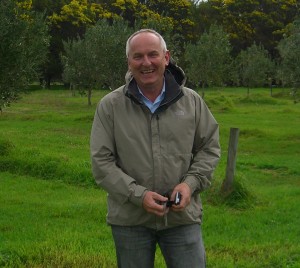
Photo: John Wholley
EVA doesn’t make a lot of noise outside its target group of contacts and much of what we have done is one-to-one. All I can say is that it has been effective and there will be more changes evident in the olive oil trade in the USA and elsewhere soon because of this work. Nothing beats consumer work, nothing – not standards, not government, not regulators – nothing. Training of the supply chain comes second in importance. I have learned this from Alexandra. The work is hard, time consuming and must be done with exacting credibility but it is the most important work we can do.
The EVA network is the best global olive oil network that I know of and I am sure it will slowly but surely expand. I have also worked with Keller Heckman San Francisco, which has championed olive oil in the USA since we started working together in 2013, as well as the National Consumers League in the USA who I met in China in 2013 – both supporters of EVA. The UCLA food law and policy team has been helpful and instructive since I met them through a Keller Heckman lawyer. I gave a presentation and tasting to a roomful of high-flying lawyers at a UCLA seminar in April 2014 and it was a hit.
And the work goes on, with presentations on both coasts of the USA. As recently as 27 September I spoke at the national meeting of analytical chemists in LA in a session on food fraud that was led by the FDA.
So, since I started as President Australian olive oil production has increased from 350 tonnes of oil in 2001 to 19,800 tonnes in 2015. We now export about 4,000 tonnes per year and consumption has risen from 30,000 tonnes in 2000 to over 40,000 tonnes in 2015. Clearly Australian olive oil has made big inroads into the Australian market.
I thought that we would produce more during this 15 year period but drought, especially in 2006 and 2007, restricted yields in many regions and had ongoing effects.
With regard to table olives, consumption in Australia has risen from 14,000 tonnes in 2001 to 21,000 tonnes in 2015, with about 4,000 tonnes of these now produced in Australia.
The standout high volume producer in Australia has become Boundary Bend with its technical arm Modern Olives. With something like 70% of the production and the lion’s share of the supermarket trade in Australian olive oil this company has come to dominate the Australian scene. I have said on many occasions that we have been very lucky that Boundary Bend has always had such a quality focus. We are also lucky that the people within Boundary bend have been willing to share so much information and research, and to be partners with the AOA and the rest of the industry in learning about olive oil production in Australia. I have to thank Rob McGavin, Paul Riordan, Tim Smith, Claudia Guillaume and especially Leandro Ravetti for their assistance to me and support over many years. This has not been an easy journey and it would not have been possible without such a supportive major producer.
My global experience has enabled me to compare what we have done with other olive industry organizations. I am satisfied that the AOA under my leadership has achieved more than any other such national industry organization in the world. This has allowed me in turn to plant the Australian olive oil flag in many parts of the world and for the AOA to have had an impact way beyond the proportionate size of our industry.

AOA president Paul Miller attended the Senate Subcommittee on California’s Olive oil Industry and Emerging Products’ hearing on Challenges facing California’s Olive Oil Industry, along with Extra Virginity author Tom Mueller. In his new role as ambassador, Miller will continue to advocate continue for better standards and truth in labelling across the global industry.
5. The Future
In my opinion the main challenge and opportunity for the AOA now is to build on all the previous work to help improve the future profitability of its members. We need greater profitability to underpin new businesses and to enable existing ones to update and improve their capability. We also need more successful large scale producers – one is not enough.
Global economic conditions, government indifference, climate, unfair competition, consumer ignorance and lack of producer and supply chain skills all still impact adversely on our industry. We can work directly to change some of these factors using extension, R&D and the collective skills within the AOA.
In my opinion we need more work in market development domestically and in export. There is certainly scope to increase consumption and awareness of high quality olive products in Australia. I am hopeful that the USA will improve as a market for quality oil as they work out that there is money in genuine quality (as well as passing Italy in volume), that Japan will keep expanding well past Australia’s consumption and that China will develop as a destination for high quality niche products. Both China and Japan are inextricably linked economically with Australia’s future. Other Asian markets are worth considering and are close to us.
Japan has a remarkable food culture. Toshiya Tada and his Olive Oil Someliers of Japan (OSAJ) are doing an appropriately remarkable job integrating olive oil into that most quality conscious of markets. I plan to keep working with OSAJ.
Food fraud, quality and authenticity are increasingly on the agenda. Perhaps the EU will take the lead on olive oil. The action in Italy and elsewhere in the EU is encouraging. Australia needs to keep working internationally to help positive change occur. Please note that the olive oil problem is a global problem, not restricted to any one country or region and we must include likeminded people from anywhere if our efforts are to be successful. Exclusion benefits the opposition.
I am sure that we will soon see more truthful labelling of olive oil – extra virgin, virgin and refined olive oil should become the three main consumer choices. Extra virgin will have its higher quality, high-end niches but the fact is that to have a useful shelf life extra virgin olive oil needs to be well above minimum standards when it is made in any case.
We will need to keep abreast of new technology and I believe that the AOA is well set to do that in partnership with HIA. No doubt we need more work on table olives and Peter McFarlane has been championing that for the AOA.
I would like to see the AOA have input into and knowledge of research on olive oil and food – the apparently synergistic interaction that improves both culinary quality and the health and nutritional outcomes for human beings. Catherine Itsiopoulos seems to be a natural partner and there may be scope to link this in with our Greek and EU contacts.
Such work underpins the notion that olive oil is a whole food and the whole is greater than the sum of its complex health giving parts which work better in the presence of each other. Therefore the best health, nutrition and lifestyle outcomes are from eating extra virgin olive oil with other good food. It also opens up the possibility of powerful work with olive oil and Asian foods.
We should be wary of reductionist research and PR that focuses only on individual components. The genetic manipulators will home in on this using new transcription technology to make other foods higher in whatever olive oil component that has been singled out – but I don’t think that they can imitate the whole, its history or how olive oil works with food.
We should never underestimate how deeply olive oil is ingrained into the culture around the Mediterranean. Nowhere is this more evident than in Greece. The many producers of good olive oil in these countries need to be our colleagues in the struggle to restore the value of high quality oil for producers, the trade and the consumers. I have seen the passion of these people; it matches all of ours and in addition has a long and valuable historical base in the food and health traditions of the Mediterranean diet and lifestyle that add value to our products as well.
Those we need to be concerned about are the few large, sometimes multi-national industrial packers of olive oil who have dumbed-down the category and promulgated falsely labelled products for short term gain. Everyone in the business has been damaged by this.
I applaud the promotion of Australian olive oil that is about Australia, sunlight, lifestyle and clean air and at the same time I would like to see the long wonderful Mediterranean heritage of olive oil respectfully acknowledged in the background.
For the AOA, I hope it continues to have many roles – leadership, extension, promotion, service provision, R&D, advocacy, networking and a good place for olive producers to be connected to.
As I finish my term as President I think of Les Parsons, Ian Rowe, Bruce Haig and Wendy Ambler before me. I hope that they are happy with where we are now – of course never satisfied
In closing this report I thank the current Board, the many, many past Board and committee members of the AOA and all my friends in this fine organization.
In particular I thank Lisa (CEO since November 2011), Peter, Chris and Leana – the executive management team. It has been fun to work with you people as President. Lisa in particular deserves special recognition for her input during all my time as President; for OSA, for the AOA, for the industry and as a trusted, forthright and capable colleague.
I wholeheartedly welcome Peter O’Meara as the new AOA President. He has my full support.
I can assure all my colleagues in the AOA that nothing has changed in my commitment to work to achieve real value for the excellent olive products made by you, the olive producers of Australia, and that I will keep working on this for as long as I can.
Paul

